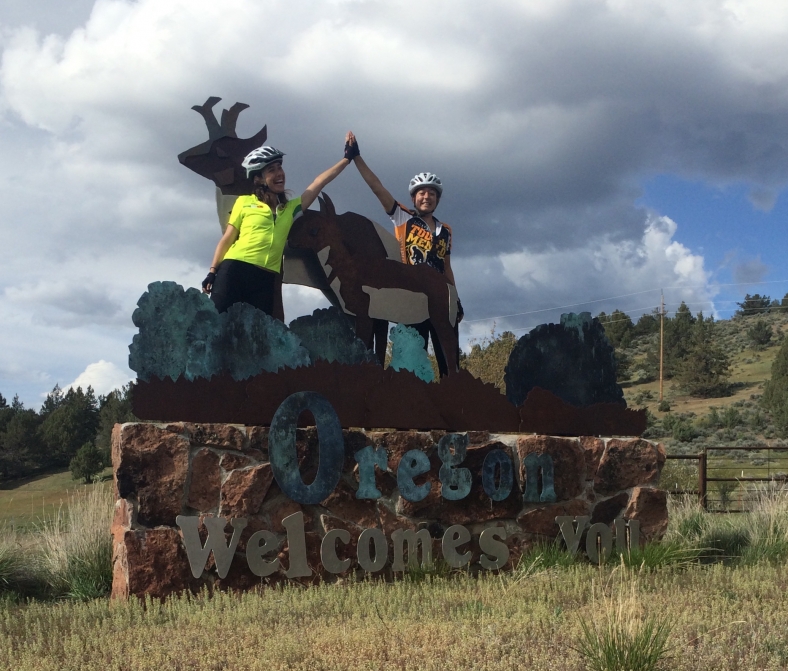Cycle for Science — the brainchild of Rachel Woods-Robinson and Elizabeth Case — is a 4,000 mile bike ride from San Francisco to New York. Along the way, Case and Wood-Robinson will make stops at classrooms and summer programs to teach science, talk with teachers and encourage girls to continue studying science, technology, engineering and math (STEM). This is the first part in a series of guest blog posts by Rachel and Elizabeth. Follow their journey on Energy.gov and their website, cycleforscience.org.
We’re Elizabeth and Rachel, and between April and July of this year, we’re biking across the country for science. We’re calling it Cycle for Science, and we’ll be updating you, Energy Blog readers, about our progress as we pedal across the nation, gear strapped to our bikes, eyes on the incredible beauty around us. Along the way, we’ll be stopping at middle schools to teach hands-on science lessons about renewable energy and the physics of bicycles. For these visits, we designed the Sol Cycle — a 3D-printable, miniature bicycle moved by a motor that is powered by the sun.
As of April 30, we just made it up the Sierra Nevada mountains and into Oregon. One state down! Many to go. Tomorrow we head out into the Oregon outback — which we hear is both beautiful and desolate. We’re bringing along a couple gallons of water, and pedaling as fast as we can to the next town with water: Riley,114 miles away.
We’ve already taught two classes: one in Sacramento, California and one in Chico, California. The Sol Cycle is central to each lesson — the solar panel converts sunlight to electricity, turning the motor to make the wheels spin. We divide students into groups and give them a bike, a solar panel, a motor and some rubber bands. We have them figure out how to put the parts together and explain to us why the bike is able to move.
It’s been so much fun to see the kids’ faces light up when they actually see the bicycles roll outside in the sunlight. It’s definitely been hands-on learning for us as well. What questions do we ask the students to prompt them to experiment with their bicycles? To help them understand the physical concepts behind conservation of energy and friction? How do we get them excited to innovate, as well as direct them in a way that they really take something from the lesson? And how do we engage the students who might not be as interested in science as some others?
RACHEL’S STORY
In Sacramento, I worked with a group where three of the students were spearheading the setup, and two girls were watching but not participating. The three students were having trouble getting the bike to move. “It’s not working!” they told me, frustrated.
I noticed that the metal clips connected to the positive and negative terminals on the motor were touching, so I brought the two girls aside and asked them what they knew about circuits. One of them said it was like a “circle of electricity”, and I agreed and explained that electrons are lazy bums and like to take the path of least resistance a.k.a. through the most conductive material.
After that I barely had to prompt them. They figured out that when two metals touch, electricity will choose that path rather than the path through the motor, and they realized that was why the wheels weren’t spinning. They were a bit timid, but I encouraged them to let the other members of their group in on their little secret. So they both pointed out the issue, and the boy who’d been toying with the rubber band said “OH! THANK YOU!” and big smiles popped up on the girls’ faces and the wheels starting spinning.
ELIZABETH’S STORY
In Chico, in particular, I worked with a seventh grader who seemed really shy to start with. He didn’t raise his hand during the question and answer period at the beginning, and he didn’t talk much to the others when we separated into groups.
But once we went outside, and started working on the worksheets, I was able to sit down next to him and start asking him some questions. We did some dimensional analysis to figure out how many miles-per-hour the Sol Cycle ran with his “happy calculator” (he showed me how to make a smiley face on it).
He was the last kid out there — tinkering on the Sol Cycle even after the bell for school ended — when one of the younger students, in kindergarten or first grade, came up and started asking about the bicycle. The seventh grader showed him how it rolled in the sun, and the younger student’s face lit up with this huge smile watching it move, even trying out some adjustments himself. It was great to see both of them excited to teach and to learn.

